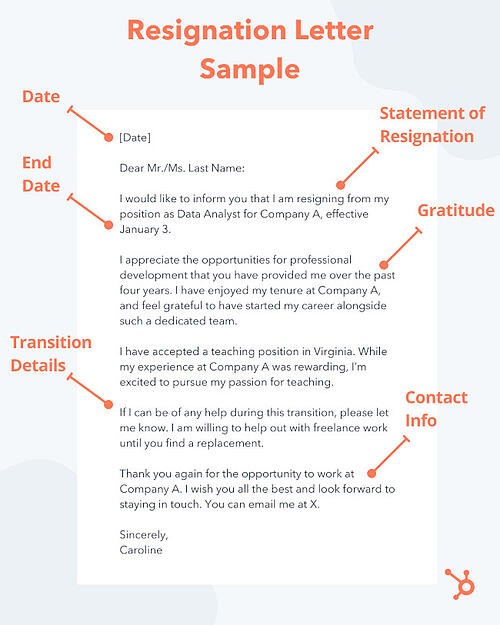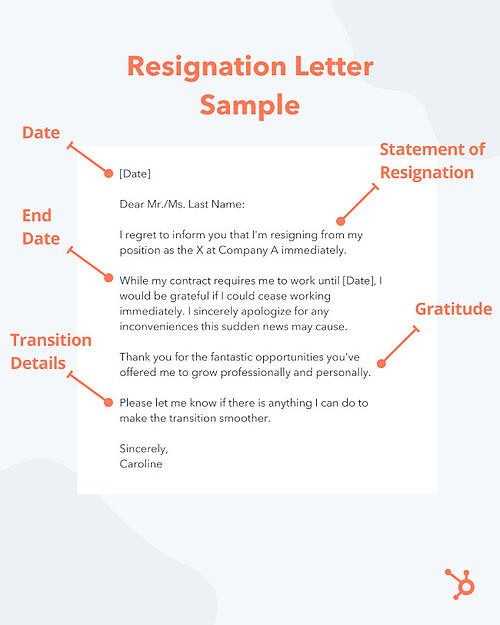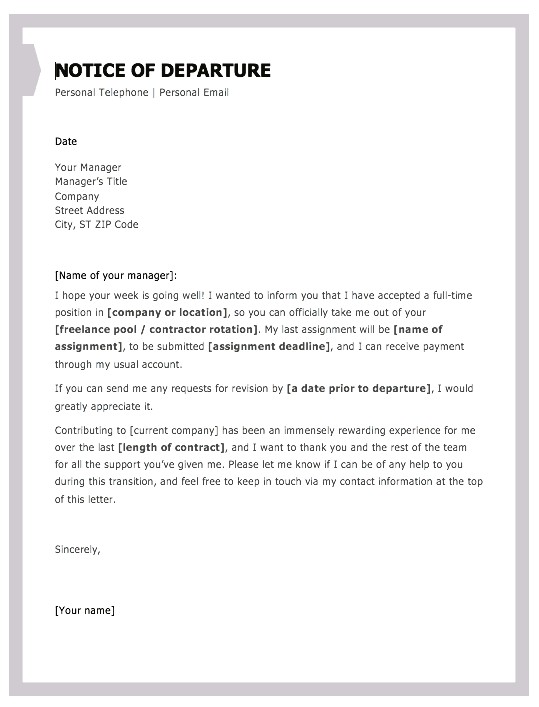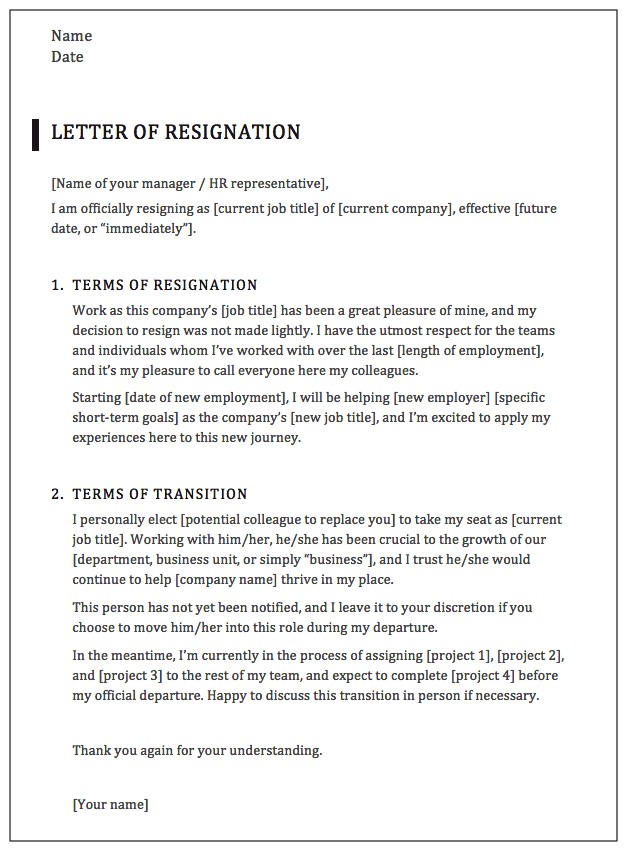If you are leaving your job, you’re not alone.
In April 2021 alone, around 4 million people quit their jobs, according to the Bureau of Labour Statistics. That number is the highest recorded since the bureau started recording such rates.
Even though millions quit their jobs every month, we understand that telling your boss that you’re leaving the company is never an easy conversation. A respectful resignation letter can mean the difference between an awkward goodbye and a chance for a long-term professional connection.
Ideally, you’ll provide a resignation letter two weeks before you leave the company. A resignation letter lets you officially announce your termination at the company and also offers essential housekeeping information, like your last day and other details about your departure.
An effective one helps you ensure a positive conversation with your boss and a smooth transition to your next journey.
But how do you write a good resignation letter? What should you include and exclude?
Writing a resignation letter can feel like a daunting task, so we’ve created a professional resignation letter template to get you started and included examples for inspiration.

What do I include in a professional resignation letter?
Writing a professional resignation letter starts with understanding each of its components:
1. Statement of Resignation and End Date
Begin your letter by stating your position at the company. This might seem redundant if you work at a small company and your boss knows you well, but it’s essential to include it since the letter is your official termination. Along with this information should be a simple statement of your resignation.
Also, providing an end date in the first body paragraph is helpful since that’s one of the first questions your employer is going to have.
Here's what this first paragraph may look like in practice:
I would like to inform you that I am resigning from my position as [Position Name] for [Company Name], effective [Date].
2. Gratitude
Take the time to consider how you’ve grown or what you’ve appreciated most about your time at the company. Be as specific as possible — perhaps the company provided professional development opportunities, or maybe you’ve enjoyed the climate the company fostered and the supportive atmosphere.
It’s also nice for your employer to receive a thank you for the time and resources they’ve used in supporting your career growth. Here's an example of what this may look like:
I appreciate the opportunities for professional development that you have provided me over the past two years. I have enjoyed my tenure at [Company Name] and particularly feel honored to have been part of such a supportive team.
If you’d like, you can include where you’re headed next, too. For example, if you’re switching industries to pursue a passion or going to graduate school, it might be appropriate to include that. For example:
I accepted a position as a [New Job Title], and I'm looking forward to [pursuing my passion in X or continuing my work with a focus on Y].
However, if you’re leaving the company for a competitor, it’s better to omit such information.
3. Transition Details
In the third paragraph, mention your willingness to make the transition easier. For example:
If I can be of any help during this transition, please let me know. I am available to help train my replacement and ensure that all my reports are updated before my last day of work.
This sentence might look different for you. But regardless of what you write, it’s good practice to include specific details regarding how you’ll help.
As an optional follow-up paragraph, briefly review the work you'll be surrendering when you officially leave the company. Although it’s technically your manager's responsibility to pick this work up and determine how it will continue, it's helpful to list all the projects and tasks you've been in charge of to make the transition even easier on the company in the interim.
If you didn’t serve in a managerial capacity or collaborate with other departments, you could skip this part.
4. Personal Contact Information
This last paragraph is optional and doesn’t need to be included all the time, particularly if you have no desire or need to use your former employer as a reference. However, many candidates choose to maintain their professional networks, so such a closing may look like this:
Thank you again for the opportunity to work at [Company Name]. I wish you all the best and look forward to staying in touch. You can email me at [Email Address].
Professional Resignation Letter Samples
With the above template in mind, let's look at a few sample resignation letters for different positions, each taking a slightly different but amicable tone to their resignations.
1. Gracious Resignation Letter Sample

2. Brief Resignation Letter Sample

3. Immediate Resignation Letter Sample
While the best way to quit a job is to give at least two week’s notice and offer to help with the transition, sometimes circumstances make that impossible. If you need to leave your job immediately without notice, you need an immediate resignation letter.
Here is a sample that can help you:

Free Professional Resignation Letter Templates
Sometimes the nature of your position merits a more specific letter of resignation when you leave. Below are a couple of templates that help these more dynamic roles make a graceful departure from the company.
1. Contractor Resignation Letter Template
If you work freelance, you might need to adjust the focus of your resignation letter so it addresses your final assignments and how exactly you'll be parting ways with your client. This includes your current duties, which tasks you won't complete, and how you'll accept your final payment.

2. Executive Resignation Letter Template
If you're in an executive- or senior-level leadership role, a quick email or two-paragraph notice to your superior might not suffice as an official resignation. Because these roles are harder to fill, you might play a more significant role in the transition period -- especially since you manage more people and decide on the direction of more projects.
The template below separates the resignation into two sections -- the first is the resignation itself, and the second is how (and with whom) the resigner's work will continue. It is just one of the different templates we have on offer.

Ready to Write Your Resignation Letter?
No matter your role, why you're leaving it, and who you're informing, be polite in your resignation letter. Gratitude and support during your departure go a long way with employers, and the last thing you want to do is leave the company on a sour note — even if you're leaving for sour reasons.
By drawing inspiration from resignation letter samples and templates, you'll protect your bridges and keep your professional network intact as you start your next adventure.
Editor's note: This post was originally published in October 2018 and has been updated for comprehensiveness.


